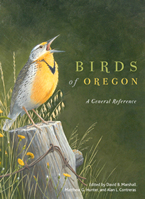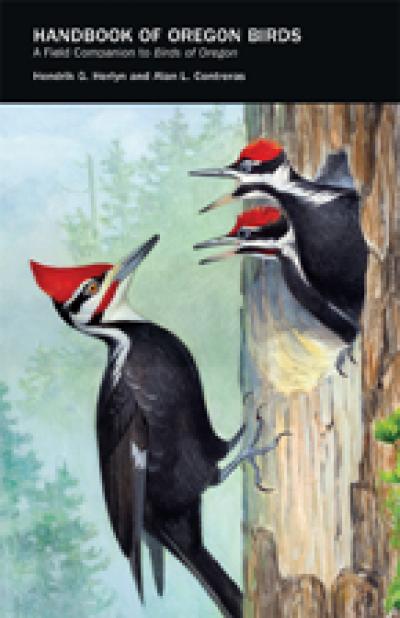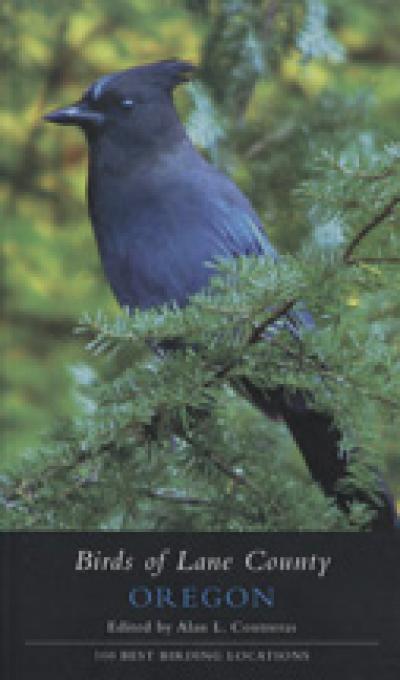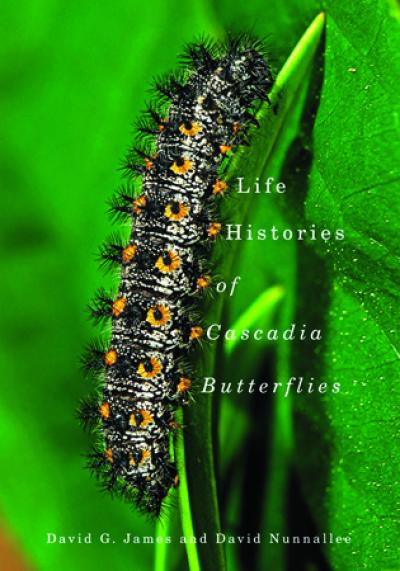
Birds of Oregon
Matthew G. Hunter, David B. Marshall, and Alan L. Contreras
Birds of Oregon is the first complete reference work on Oregon's birds to be published since Gabrielson and Jewett's landmark book in 1940. This comprehensive volume includes individual accounts of the approximately 500 species now known to occur in Oregon (about 150 more than in 1940), including detailed accounts of the 353 species that regularly occur and briefer accounts of another 133 species that are considered vagrants. A separate chapter covers extirpated and questionable species as well as those which have been introduced but have not become established.
Oregon is long overdue for a book of this kind. Although northern states generally support fewer species of birds than more southerly ones, Oregon ranks fifth behind only Florida, New Mexico, Texas, and California in terms of numbers of species. This is due to its varied climate, its wide range of habitats, and the mild winters over much of the state, which make it an important wintering area.
Birds of Oregon is not a field guide for identifying birds, although it describes the appearance and any unique or special characteristics of each species, and approximately 100 species are illustrated with attractive line drawings. Instead, it compiles and presents in a single large volume what is known today about the population status and distribution of each species, as well as their habitat requirements and diet, their seasonal activities and behavior, where and how they might be found, and any conservation problems. It includes about 200 range maps that reflect the work of more than 700 volunteers who participated in the Oregon Breeding Bird Atlas project, as well as other sources. Subspecies--of which Oregon has many because of the variability of the state's avian habitats--are listed with their ranges, thus providing the first accounting of subspecies in the state since 1957.
In addition to the species accounts, Birds of Oregon also includes a discussion of changes among Oregon's birds since 1940 and a description of the state's nine ecoregions and how they relate to bird species.
Approximately 100 contributing authors volunteered their time and expertise to create Birds of Oregon, and numerous other individuals reviewed drafts of the species accounts to insure that they are as accurate and up-to-date as possible.
Although heavily referenced with approximately 4,000 literature citations, Birds of Oregon is written in nontechnical language and will appeal to a broad audience, including birders, wildlife biologists, land managers, conservationists, naturalists, hunters, and wildlife enthusiasts in general.
This new paperback edition includes an annotated list of species that have been added to the official state bird list since the book was first published in 2003.
Harry B. Nehls, Senior Contributor
M. Ralph Browning, Taxonomic Editor
Jonathan P. Brooks, Cartographer
Illustrations by Elva Hamerstrom Paulson
Comments and Errata
http://home.comcast.net/~matt.hunter/bogrerrata/
About the author
Matthew G. Hunter is a consulting wildlife ecologist who previously worked as a wildlife biologist for several federal and state agencies. He lives in Corvallis, Oregon.
Read more about this author
David B. Marshall was a biologist for the U. S. Fish and Wildlife Service for 32 years and is currently a wildlife consultant. He has published numerous articles in scientific journals and is widely considered the preeminent authority on Oregon birds. He lives in Lake Oswego, Oregon.
Read more about this author
ALAN L. CONTRERAS, now retired from a career in higher education, is a writer, editor, and birder. His numerous books include Birds of Oregon: A General Reference and Afield: Forty Years of Birding the American West.
Read more about this author
Preface
Acknowledgments
About This Book
Chapter 1. A Summary of Changes to Oregon's Avifauna Since 1935
Chapter 2. Avian Habitats in Oregon
Chapter 3. Species Accounts
Chapter 4. Supplemental Species List
Glossary
Appendix A: List of Common and Scientific Names of Plants and Animals
Appendix B: Changes in Scientific Bird Names Since Publication of Garielson and Jewett (1940)
Appendix C: Oregon Breeding Bird Atlas, Christmas Bird Counts, and Breeding Bird Surveys
Sources
Printed and Electronic Material
Personal Communications
About the Editors and Authors
Index of Common Names
Index of Scientific Names
About 65 years ago, two distinguished government wildlife biologists, Ira N. Gabrielson and Stanley G. Jewett, began writing the first Birds of Oregon. It was published in 1940 by what was then Oregon State College (now Oregon State University). Gabrielson and Jewett's book was a landmark for the day, and is widely cited in this volume. Like this work, it is not an identification book; rather it emphasizes distribution, habitat, and population status. It represents not only 35 years of field work conducted by these two early biologists in conjunction with their duties as animal control agents of the U.S. Biological Survey, but also the writings, research, and collecting of others, including but not limited to Meriwether Lewis, William Clark, John Kirk Townsend, Charles Bendire, Alfred Webster Anthony, O.B. Johnson, Arthur Roy Woodcock, Alfred C. Shelton, Alex Walker, George Willett, and William L. Finley.
Gabrielson and Jewett worked at a time when field guides were nonexistent and good optics were primitive and financially out of reach of the average person. The state's transportation infrastructure was also primitive, and parts of the state were accessible to automobiles only during part of the year, or not at all. Extensive offshore birding as we know it today was not within reach of these two men.
This was also a time when collecting both birds and eggs was in vogue as a hobby and scientific endeavor. The basic tool for an ornithologist was a .410 gauge shotgun loaded with dust shot. Specimens were prepared as study skins and eggs blown so they could be preserved.
Only with specimens could a new finding or unusual record be confirmed. Museum specimens left few identification doubts when sightings were difficult and impossible to confirm with photographs or follow-up observations. At the beginning of the twentieth century, birding as we know it today was non-existent.
The inability of amateur birders to conduct satisfactory surveys can be illustrated by the fact that Portland's first Christmas Bird Count, conducted in 1915, listed only 16 species recorded by three people. Not until 1933 did the count exceed 30 species. This contrasts with 100+ species recorded by about 75 people today.
Since Gabrielson and Jewett's time, birding has become a popular and fashionable hobby. Just before and immediately after World War II, universities began training significant numbers of wildlife biologists and ornithologists who gradually became a force in resource agencies and universities. The information contained in this volume includes contributions from (1) research financed by resource agencies and conducted in part by graduate students, (2) resource agency biologists, and (3) observations made by an army of advanced birders. Examples of the latter include the recent completion of the Oregon Breeding Bird Atlas project headed by Paul Adamus of Oregon State University, the Breeding Bird Survey sponsored by the Biological Resources Division of the U.S. Geological Survey, and the Quarterly Journal of Oregon Field Ornithologists, Oregon Birds, now in its twenty-sixth year.
While professionals have worked mainly on habitat and life history requirements, amateurs have concentrated on distribution. However, there has been much overlap, and both have contributed, through various means, information on population numbers and trends.
During the early years of my professional career spent as a field biologist in various states, I came to appreciate the value of state bird books as references and realized the need to update the original Birds of Oregon, but full-time employment precluded my participation. Fortunately, Birds of Oregon: Status and Distribution (Gilligan et al. 1994) filled an important void. It is frequently cited in this volume, but the reader will find Birds of Oregon: A General Reference differs in terms of delineating habitat requirements, population numbers, historical changes, and by citing information sources in the species accounts. Other recent contributions to Oregon ornithology include Northwest Birds in Winter (Contreras (1997); the Atlas of Oregon Wildlife (Csuti et al. 1997; 2nd edition 2001), which features distribution maps based on habitat types for birds and mammals that reproduce in the state; and the Oregon Breeding Bird Atlas available on compact disk.
Some history on how this book emerged appears appropriate. Since boyhood, I had realized that the time would come to update Gabrielson and Jewett's book and that I could even become involved. Gabrielson and Jewett were both mentors of mine. In 1997, I learned that Oregon State University Press was interested in publishing a new state bird book. I submitted to them a proposal which included sample species accounts and a book outline that I felt would represent the needs of a wide group, including wildlife biologists, other natural-resource professionals, conservationists, birders, and hunters. Two very capable individuals, Matthew G. Hunter and Alan L. Contreras, volunteered to help as co-editors. Each brought special talents to the project. Hunter was experienced as an offshore and inland birder, had worked on several avian research projects in Oregon, and had academic experience and needed computer skills. Contreras' perspective was that of one of the state's premium birders with a wide knowledge of published literature on Oregon birds. We began enlisting experts on various species as potential authors; very few declined the invitation to write accounts, and others whom we had not thought of volunteered. An impressive list of professional wildlife biologists and ornithologists, along with some advanced amateur ornithologists, emerged.
Soon after the first draft species accounts had been written, it became clear to the editors that neither they nor the authors were qualified to adequately address the taxonomic status of subspecies. We began consulting with M. Ralph Browning, an Oregonian who had recently retired from his position as an avian taxonomist with the U.S. National Museum. Browning subsequently consented to become Taxonomic Editor. Harry B. Nehls, longtime secretary for the Oregon Bird Records Committee of the Oregon Field Ornithologists, also became a major contributor. Nehl's background on bird rarities of the state made him an important reviewer and author of vagrant or rare species accounts.
Another need was for illustrations. Hunter introduced me to Elva Hamerstrom Paulson, whose superb artistic talents were obviously a fit. Her background as the daughter of two famous ornithologists undoubtedly contributed to this. Finally, Jonathan P. Brooks, a cartographer with Oregon State University, consented to prepare maps based on Oregon Breeding Bird Atlas data.
Our main objectives for this book were to (1) document the status and distribution of the state's birds as known at the beginning of the twenty-first century; (2) set forth what is known of their habitat requirements in terms of food, cover, and space; and (3) stimulate research and continued investigations by showing what is not known. One of my hopes is that the book will dampen some of the rhetoric and misunderstandings that have emerged from resource extractors on one side and environmentalists on the other regarding the needs of controversial species. And by describing habitat requirements, we also show that habitat destruction for one group of species invariably creates habitat for another group; yet maintaining habitat diversity is necessary to sustain all the state's birds.
More than anything else, we hope this book will constitute a contribution to the conservation and enjoyment of birds found throughout Oregon.
David B. Marshall
"The reigning ultimate birding resource for the Northwest."
--The Oregonian
"This book… is the first exhaustive work on the subject since Jewett and Gabrielson's landmark treatment 63 years ago. If you want to know if a bird visits Oregon, and when, or breeds here, or what kind of habitat it needs, or what it eats, when it migrates, whether its numbers are increasing or decreasing, what threats it faces, this is your one-stop shopping."
--Mail Tribune
"This is a tremendously valuable and important work, and a must-have for any regional birder, ornithologist, wildlife manager, and policy maker, or anyone simply interested in birds of the western United States… One of the highlights of this book, and one that extends to birders and ornithologists well beyond Oregon's borders, is the exhaustive treatment of subspecies."
--Western Birds
"With this book and a good, handy identification guide, you're set for a lifetime of Oregon birding."
--The Register-Guard





 As a boy growing up in Portland in the 1930s, Dave’s passion was birding. With friends he would bike from Mount Scott to Kelley Point, looking for birds—early escapades that are recounted in “Hometown,” a short essay by Dave and Tom McAllister that appears in the new edition of
As a boy growing up in Portland in the 1930s, Dave’s passion was birding. With friends he would bike from Mount Scott to Kelley Point, looking for birds—early escapades that are recounted in “Hometown,” a short essay by Dave and Tom McAllister that appears in the new edition of